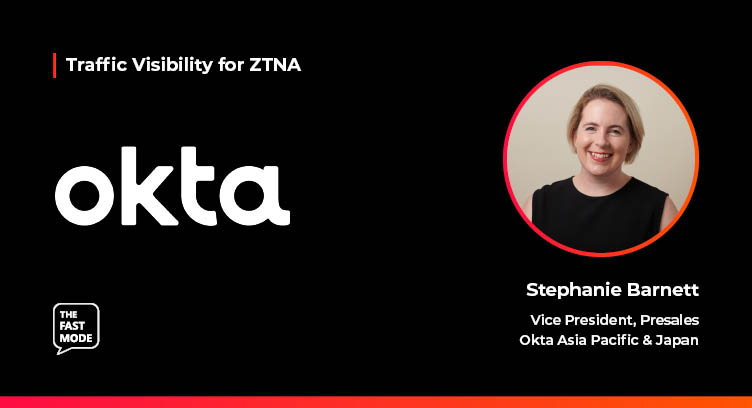The Fast Mode spoke to Stephanie Barnett, Vice President of Presales at Okta Asia Pacific & Japan on the impact of traffic visibility on ZTNA networks. Stephanie joins us in a series of discussions with leading cybersecurity and networking vendors, assessing the evolution of ZTNA technologies, the roadmap for ZTNA deployments, the benefits of ZTNA for enterprise and telco networks, and the need for real-time traffic visibility technologies such as DPI for ZTNA.
Ariana: How well are zero-trust principles espoused by today’s networks?
Stephanie: The Zero Trust concept was designed with the following assumption: “never trust, always verify.” Traditional network security infrastructure was based on the castle-and-moat approach, where resources are protected by corporate perimeters with network-security appliances. This approach worked on the assumption that everything within network perimeters was safe and trustworthy.
Yet the sudden shift to remote work, as well as the distributed nature of today’s networks and devices meant the traditional network security model is no longer tenable. As the legacy perimeter model continues to fail modern security needs and performance requirements, we see growing adoption of Zero Trust strategies in today’s networks.
In fact, the latest 'State of Zero Trust Security' report 2023 by Okta reveals that Zero Trust has now become mainstream. The report shows an exponential increase in the adoption of this contemporary security framework in the last two years, with 61% of organisations having a defined Zero Trust initiative in place and a further 35% intending to implement one shortly.
Ariana: Why is ZTNA the future of enterprise security?
Stephanie: Perimeter-based security was not built for dynamic, cloud-driven environments, and hence is failing to evolve and adapt to modern security needs. As organizations realign their security strategies, it’s essential to move on from stopgap measures and invest in transformative security approaches that help protect IT assets in perimeter-less environments.
Identity-powered security recognizes that understanding the Identity of users and their devices is foundational to securing access to an organization’s most critical resources. Whether it’s an employee, a contractor, an endpoint, or a server, every entity within an organization needs to be authenticated into systems and gain authorization to perform actions.
Taking an Identity-first security approach - with a focus on identity and access management (IAM) - marks a significant departure from security’s traditional role as a cost center and opens doors for security teams to act as business drivers within an organization. This strategy, in turn, promotes rapid and agile adoption of technology across an organization while reducing risk.
Ariana: What do you consider are the core features (must haves) of ZTNA?
Stephanie:
When architecting a cutting-edge Zero Trust framework, organizations must consider a few Identity-related security mechanisms. Okta believes the below three tenets are key, and provides solutions to support them:
- Leverage least privilege access: As a core tenet of Zero Trust, least privilege ensures that the right level of access is granted to the right sources, at the right time, from the right device and location, with that access being continuously monitored.
- Consolidate identity with a unified solution: Centralizing identity makes deploying and managing granular and context-based policies easier across your technology stack.
- Comprehensive integration across the security stack: Zero Trust requires different security solutions to work together effectively, establishing multiple layers of defense and exchanging information seamlessly.
Stephanie Barnett is the Vice President of Presales for Okta’s Asia-Pacific & Japan (APJ) region. Stephanie leads Okta’s team of solution engineers, system architects and technical specialists across the APJ region, assisting the sales team in acquiring and supporting customers and generating growth. She also oversees pre-sales operations and is in charge of driving Okta’s scaled strategic, enterprise-wide go-to-market initiatives.
This interview is a part of The Fast Mode's Next-Gen DPI Traffic Visibility for ZTNA segment, featuring over 40 leading cybersecurity and networking solution providers and their views on the importance of traffic visibility for ZTNA. A research report on this topic will be published in January 2024 - for more information, visit here.


















